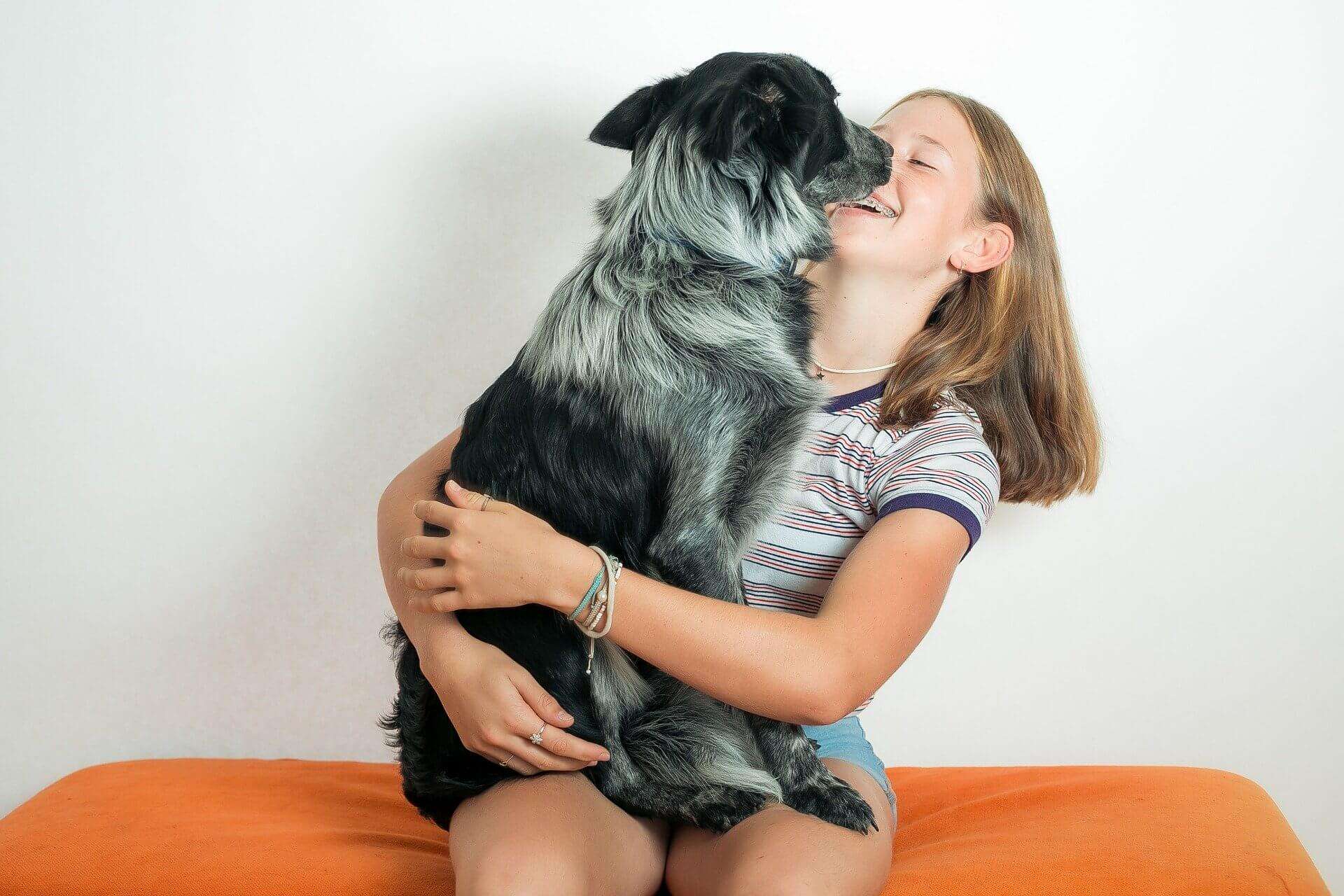2020-09-22

You may have heard about how therapy dogs in classrooms can perform wonders — they can help relieve student stress, help kids learn to read, and even boost test scores. You may also see therapy dogs work as part of the volunteering team with their handlers in places such as schools, hospitals, and carehomes.
So, are therapy dogs the same as assistance dogs? We get questions about whether a therapy dog counts as an assistance dog all the time. In this article, let’s explore the traits and requirements of a therapy dog and find out the answer.
In this article
1. What Exactly is A Therapy Dog?
2. What conditions could be assisted by a Therapy Dog?
3. Why Therapy Dogs should be trained first?
4. How to get a Therapy Dog in the UK
Step 1 Choose a therapy dog candidate
Step 2 Therapy Dog Training
Step 3 Therapy Dog Registration
What Exactly is A Therapy Dog?
Therapy dogs, which are called “comfort dogs” sometimes, support a person’s mental health by providing attention and comfort. Their sweet unconditional love may have a therapeutic benefit to those who face health challenges. Unlike assistance dogs, however, anyone can get help from a therapy dog.
Assistance dogs are specially trained to perform specific tasks to help an individual who has a disability. Assistance dogs have access privileges in public places such as on planes, restaurants, supermarkets, etc, while therapy dogs do not have the same public access as assistance dogs.
The question at the beginning of the article should unveil itself now: Therapy dogs are not assistance dogs.
What conditions could be assisted by a Therapy Dog?
Some mental health challenges and psychiatric disorders are known to respond well to therapy dogs, such as
• Depression
• Bipolar disorder
• Autism
• ADHD
• Post-traumatic stress disorder (PTSD)
• Alzheimer’s disease
• Emotional challenges result from physical health problems

Why Therapy Dogs should be trained first?
For the safety of the dog and the people they visit, all therapy animals must be very calm, friendly, sociable, and must be trained to respond to commands regardless of any distractions around.
They are trained to be friendly, patient, gentle, and at ease in all situations:
– be willing to handled or cuddled by strangers
– have no sensitivity to rough stroking or petting
– reach excellent on-leash obedience levels
– be tolerant of unusual smells and sites, such as wheelchairs and medical devices, as therapy dog and handler teams usually visit health facilities
– have no fear of unsteady movement in humans
– interact with other animals in a positive way
– have no food or toy aggression
– no jump on or even paw at people

How to get a Therapy Dog in the UK
If you would like to own a therapy dog, the process is straightforward, but it does take some time and effort.
When you pick a therapy dog candidate, you should watch your dog closely and objectively at first to determine its true temperament. Any breed of dog can be used for therapeutic purposes, so long as it fits these requirements:
– Be healthy and over one-year of age
– Stay calm in high distracting situations
– Enjoy human contact
– Present a stable temperament
The therapy dog candidate should also be well-trained in basic obedience, and easily adaptable to novel noises, places, smells, and equipment for different purposes.
Many people prefer to choose their domestic dogs as therapy dogs so that they can be trained and then accompany their family members or friends (mostly the elderly or patients).
Step 2: Therapy Dog Training
You can choose to train a therapy dog on your own or with professional assistance. Training a therapy dog is no easy task, and often requires a lot of work on behalf of both the dog and the handler. Here’s a good place to start: How to Train Your Puppy to Become a Therapy Dog
You can contact your local hospital, special needs education organizations, or nursing home to see if they have their own animal therapy programs. Different organizations have varying criteria. Double-check the requirements before you enroll in a particular course.

Step 3: Therapy Dog Registration
Before having your dog as a therapy dog on a voluntary basis, it is recommended to first assess you and your dog work as a team. Here is a checklist for your reference:
No 1: The dog will accept friendly strangers and allow people to approach and speak to the handler in a natural, everyday situation.
No 2: The dog will sit and stay politely for petting from people other than the handler.
No 3: The dog will walk on a loose lead.
No 4: The dog will walk through a small crowd.
No 5: The dog must respond well to verbal commands like ‘sit’, ‘stay’, ‘come’, and ‘heel’.
No 6: The dog will come when called by the handler from about 10 feet away on a leash.
No 7: The dog will socialize with other dogs and display no fear or aggression.
No 8: The dog will stay calm in high distracting situations.
Once you decide to provide comfort and support to people with your dog partner, we would like to suggest that you register your Therapy Dog with supportdogcertification.org as a certified Therapy Dog before you contact the places that you will go with your dog partner to support.

Whether you are bringing a new assistance dog into your privately rented home or renting a new home with your existing assistance dog, it is a good idea to talk with the landlord in advance.
If you are working with an ADUK member they should be able to provide support and advocacy for you if you experience any issues.
Under the Equality Act 2010, it is against the law for service providers, including landlords, rental agencies and housing associations to treat disabled people less favourably because of their disability, or because they rely on an assistance dog or guide dog.
Landlords, rental agencies and other housing providers must make reasonable adjustments for disabled people who use assistance dogs.
A landlord may be required to make changes to any policies or practices they have which may disadvantage a tenant because of their disability. This includes making changes to a tenancy agreement. For example, saying pets are not allowed in the property should be changed to allow a disabled people to have their assistance dog.
A landlord cannot increase rent or charge additional cleaning fees to assistance dog or guide dog owners, even if a contract states they charge extra for pet fees. An assistance dog should not be treated as a pet in this context. In the unlikely event of the assistance dog causing actual damage, charges could be made.
There is no register or certification process for assistance dogs in the UK. Whilst all assistance dogs trained by members of ADUK are issued an ADUK Identification Booklet, not all assistance dog owners have papers or ID, nor do they require ID by law.
The Equality and Human Rights Commission has produced a useful resource that outlines disabled people’s rights to accessible housing. Included in this guide is a case study involving an assistance dog owner.
Download ‘Accessible and Adaptable Housing in England: A guide for disabled people and the organisations that support them’
With the right training, those dogs who love to be around people and are comfortable with novel items and noises can make great therapy dogs. Wherever possible, training should begin from being a puppy, however there are many cases where rescue dogs have made fantastic therapy dogs too.
If you are thinking of training a puppy for animal assisted therapy, it’s vital that he or she is socialised from a young age, both with humans and other dogs, so that they become balanced and grounded in adulthood. They should also become habituated to unusual noises, novel items and different textures. Puppies have what is called a ‘critical socialisation period’ between the ages of approximately 3 and 12 weeks. During this phase, it’s important to give your puppy lots of positive experiences around different sounds, sights, textures and smells. Watch their body language and never force them into situations that they’re not comfortable with. Take it slow, provide lots of gentle encouragement and always give them a choice as to whether they want to interact with something or not. This is vital when building their confidence.
Regardless of the age of your dog, before thinking about enrolling in therapy, it’s important that they have basic obedience training. This includes sit, lie down, come, walking to heel and stay. It’s also essential that they are taught not to help themselves to food lying around as, depending on the establishment you are looking to visit, there may well be tempting plates within reach. A strong ‘out’, ‘drop’ and / or ‘leave’ cue is also recommended. Therapy dogs don’t need to know any fancy tricks (although we’re sure that would put an extra big smile on people’s faces!), it’s more important that they are calm and obedient.




